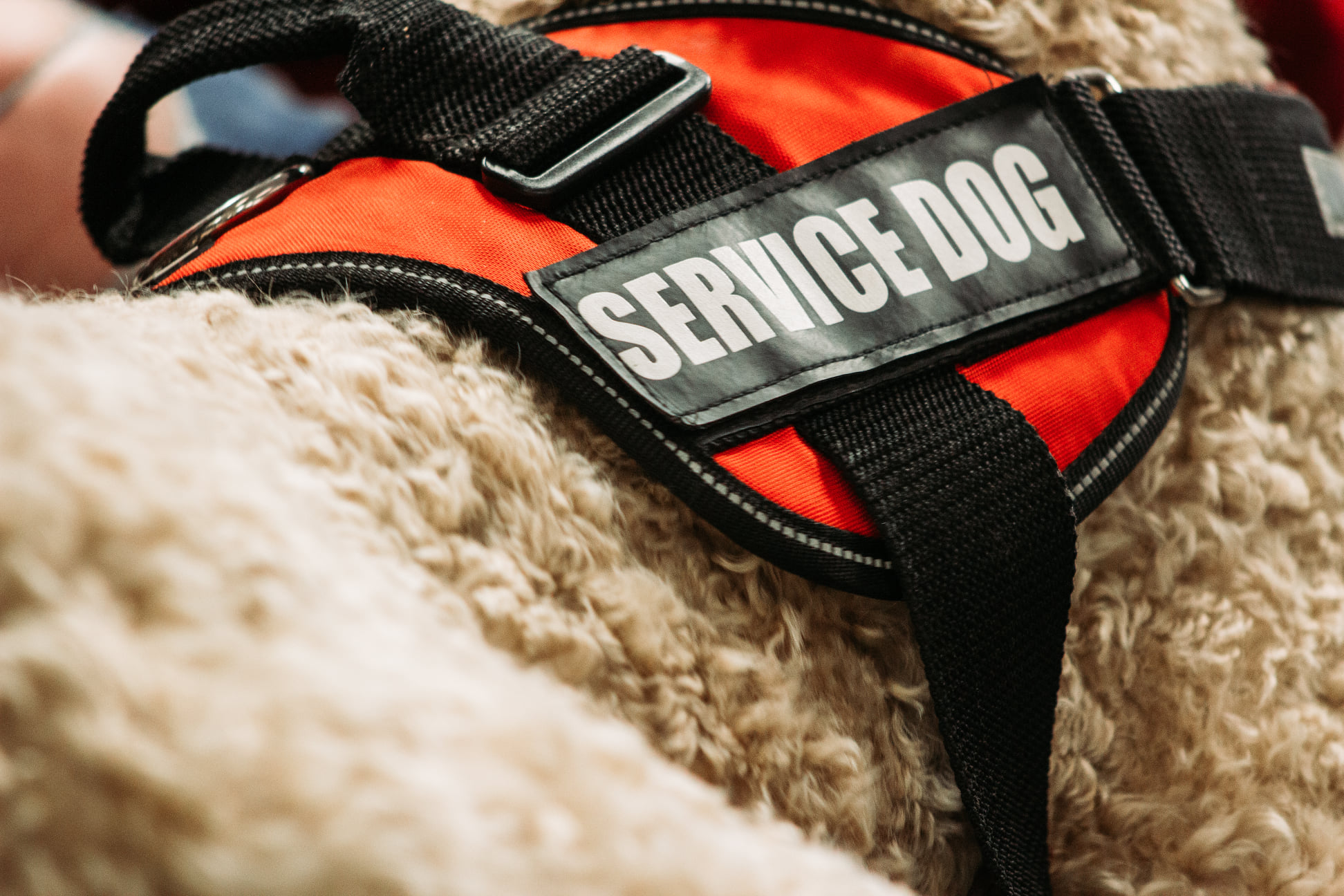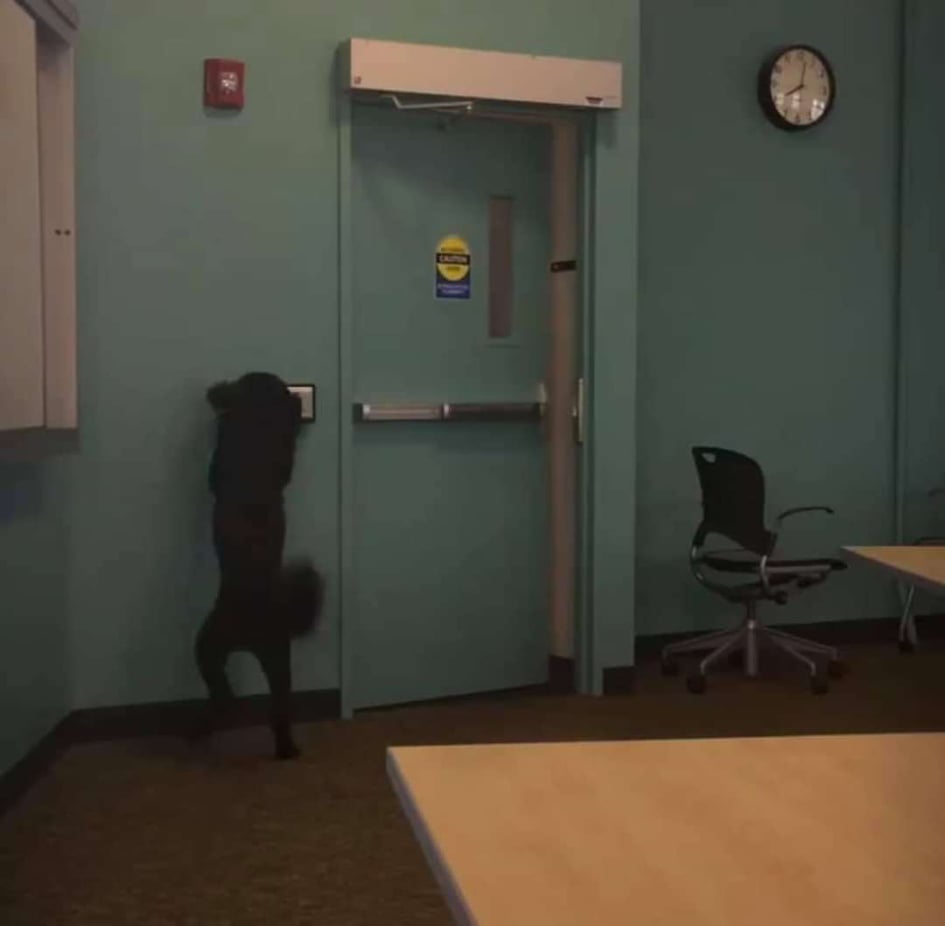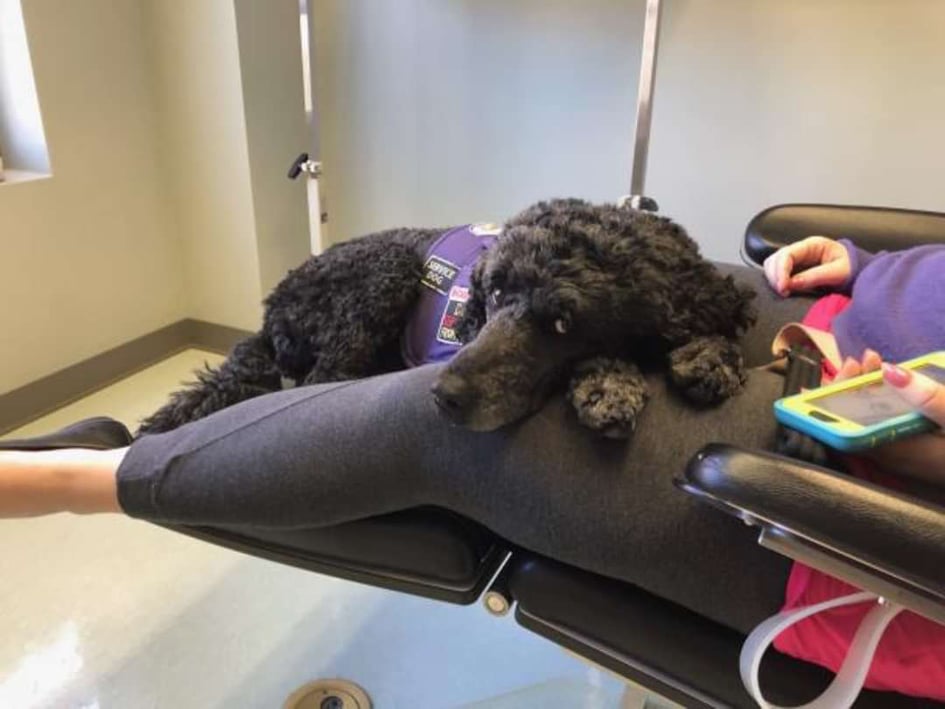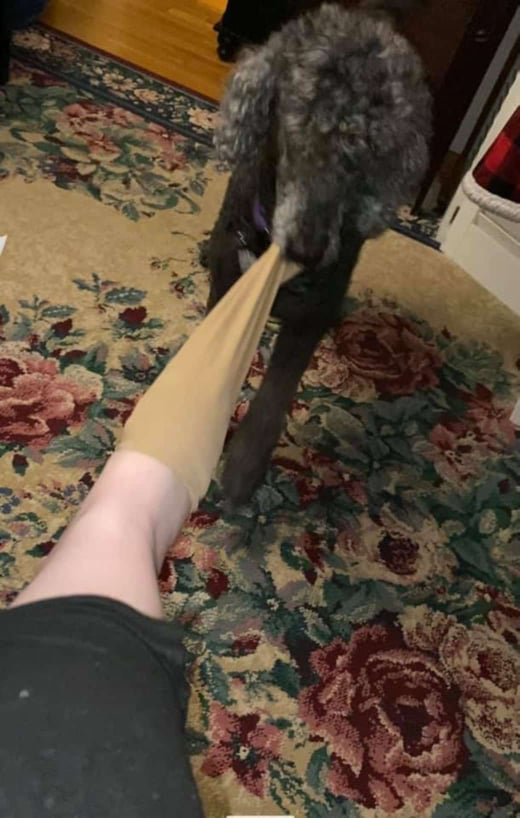
Considerations for Selecting a Pup as a Service Dog Prospect part 2
The following blog post was written by Jillian Emerson, owner and breeder of American Poodles at Work, APAW. Jillian’s program is currently on hiatus, but you can learn more about it here. This blog post is the continuation of the first, which can be found here.
Overall Characteristics of an Assistance Dog Prospect
Required Traits
For any dog to work as an assistance dog with public access, they need to be smart, biddable, motivated to learn, comfortable around strangers and all types of distractions/sounds, decently confident, have a strong work ethic, good problem solving skills, and be good at generalizing (apply their skills to new contexts without needing additional training). The dog should not require a leash or any other device to control them; even if all gear is off/dropped the dog should maintain the same level of proper response to handler and ability to work regardless of the environment.
Disqualifying Traits
An assistance dog can not be aggressive under any normal* circumstances, not reactive or overly distracted by other dogs/animals, not distracted by prey or movement such as blowing leaves or cyclists, can’t bark unless cued to or lunge in play/aggression (no barking/lunging at other dogs, strangers walking into a room, people shouting, kids running, etc), can’t bathroom in inappropriate places, and can’t do anything that affects/interferes with the property of others. The dog can’t be uncomfortable or anxious; they need to be content enough that their focus can be on working for their partner, not concerned about the environment.
*When might aggression be ok? These are situations so rare as to expect that most dogs (and handlers) will never encounter a qualifying situation in their entire life… for example, a dog defending themselves or handler from an actual, active attack by a human or other animal. This does not excuse a dog from acting aggressively because they ‘think’ something is a threat. If, as the result of an experience, a dog develops an aggressive response to future situations which are not active threats, the dog can not be worked in public until their responses have been reconditioned back to normal (or, the dog may have developed a genuine anxiety due to the experience, and should be permanently retired from working in public). Anything can happen in public, and it is not rare for children to run up from behind and grab/hug a dog without warning – the dog’s response can not include a bite, and the dog should not become uncomfortable enough to have any lasting apprehension. A proper response is friendly and playful, or mild curiosity while stepping closer to their handler.
Temperament Assessment
There are many ways to assess a dog or puppy to determine if they might be a suitable assistance dog prospect, and for specifically which role/s. More important than the assessment method used, is the experience of the assessor both with evaluating dogs of that age and with knowledge of assistance dogs in general and specifically the role/tasks that will be required of the dog for the particular handler. It is also important for the selection of an assistance prospect to be based on the dog’s responses during assessment both with a stranger (generally an experienced assistance dog trainer) as well as an evaluator the dog is bonded to (generally the breeder/owner). The age at assessment has a significant impact on what traits are considered beneficial vs detrimental.
The Volhard Puppy Aptitude Test is one of the more familiar methods of assessment, and for the majority of breeds the most predictive results are found when the evaluation is performed as close to 49 days old (7 weeks) as possible. More than a few days in either direction can result in significantly different responses based on the quickly changing developmental stages of puppies. The Volhard PAT is a series of exercises such as encouraging pup to follow the tester around the room, response to being gently held belly-up for 30 seconds, response to a tossed retrievable item, response to being startled, etc; each response is scored 1-6, with low scores corresponding to high confidence/assertiveness/aggression, middle scores meaning a ‘softer’, social pup, and high scores indicating fear and less desire for social interaction. An assistance dog prospect will mostly be a combination of 3’s and 4’s.
The Volhard test is best performed on a whole litter (or selection of available littermates) as the results are more based on where a puppy falls within the spectrum of their litter rather than a full assessment of the individual. It is important for an evaluator who is selecting a prospect to know as much as they can about the family prior to determining if it’s worth looking at the litter for the role they are seeking. A litter from working or performance lines will likely have pups who receive the middle scores, but are still likely to mature into dogs with too much drive and intensity to be successful for most assistance roles. On the flip side, a sensitive litter can still receive all of the right scores but take significantly longer for the pups to give any response, indicating that the pups are unlikely to mature with the confidence needed to work through the challenges of a public environment. A litter that is bred for the traits needed by an assistance dog may produce all puppies in the suitable range; it may also produce puppies which score too high or low yet at maturity are still closer to being an assistance dog prospect than pups with ‘better’ scores from the ‘wrong’ litters. The needed characteristics are highly genetic, so just like selecting a dog for any other working role it’s important to select a line where the characteristics run strongly through most relatives for multiple generations. This is why so many assistance dog programs now only work with purpose-bred puppies – the success rate is incredibly higher than average, and often with less effort on the part of the raisers/trainers because the right genes are in place.
Raising Style and Exposure, Especially if Remaining with Breeder Beyond 8 Weeks
For breeders who wish to place pups as assistance dog prospects, the pups will greatly benefit by having many lessons properly introduced prior to 8 weeks old. If puppies will be staying with the breeder longer, these areas are critical to be addressed during the extended stay.
- Work for food (preferably regular kibble, not something ‘special’), lure many positions/behaviors such as will be required as a working adult – sit, down, stand, front paws on objects, all paws on objects, crawl under objects, turn in circles, paw targets, nose targets, etc.
- Retrieve and tug games – use a variety of objects/textures, focus on coming back to you (with or without object), then focus on continuing to hold objects during petting; for tugging, teach a slow and steady, straight tug as will be needed for pulling of socks or opening doors, and encourage pup to bring object back as soon as pressure is gone (don’t let them run off with the prize)
- Crate and house training – acclimate pup to being separated from littermates, even if just crated individually for some meals and short naps; encourage pup to bathroom in a variety of locations on cue – tall and short grass, mulch, stones, pavement, woods, etc. Practice in various weather, day and night, at least sometimes with you very close and/or on-leash.
- Body awareness – practice exercises that help build coordination and awareness of all 4 feet, head, hips, tail.
- Confidence boosting – create learning experiences and adventure walks which allow the pup to push themselves slightly out of their comfort zone and be met with success, such as climbing rough terrain (even just 2’ – doesn’t need to be much!) and pushing through tall weeds or underbrush.
- Problem solving – create challenges for the pup to solve; drop kibble under a low object so they need to swipe it out with their paw; put a toy in a drawer which they can access by tugging a pull-tab.
- Acclimate to sounds, sights, movements – for an assistance prospect, acclimation means teaching them to be comfortable with these stimuli but to focus on the handler for praise. Use CDs for sounds, windsocks and other playing people/dogs for sights and movements, etc.
- Exposure to people, animals, travel – this needs to be done cautiously based on vaccination status/health risks, but puppies should meet many people who look/smell/act in many ways; they should be exposed to other animals if able, and again encouraged to be comfortable but to focus on you not encouraged to interact with the animal; pups should have some car ride experience beyond travel to the vet – even just going for a drive, or going to a store and just sitting in the parking lot watching people and cars pass from the safety of the crate is great experience.
- Focus on handler, not focus on interactions with environment – this cannot be understated; the success of an assistance dog prospect largely rests on their ability to stay focused on their handler regardless of their surroundings.
Additional Considerations for Placing an Assistance Dog Prospect
So, let’s say a home comes to you seeking an assistance dog prospect – it sounds like a great home and you have/will raise the litter with experiences such as those outlined above. What else needs to be considered? Here are a bunch of important questions – some for you as a breeder, but mostly for you to bring up with the home to verify that they’ve considered how they will handle these situations, and that they are realistic in understanding that there is a significant chance that the puppy won’t meet their needs – or that they won’t be able to meet the demands of raising and training the puppy as an assistance dog.
Be honest with yourself as to the likelihood of success; is it the right line, the right litter, and do you have the right pup for the role? If raised exactly right by an experienced assistance dog trainer, what rate of success could be expected? What is the experience of the home that has reached out to you? What resources do they have lined-up to help them – and what experience do those resources have? If the dog needs to be released from training, what’s the plan – will the home keep the dog as a pet, or will they need to return the dog to you, or rehome them? Will they start over with a new dog (and would they want you to replace the pup with another prospect? That’s not reasonable under most circumstances, but it would be fairly typical of a program so the home could logically assume the same)… if they do get another prospect from any source, how much time will they still have for working with the initial puppy; what if the reasons the first didn’t succeed are due to behavioral issues that could be taught to the next prospect? If the home will be sending the pup to a board and train location, have you verified the credentials and are you comfortable with your pup living there for a period?
Assistance dog role aside, if this is a novice pet home (or coming from a very different breed), the home may want a lot of guidance and general support from the breeder; this is normal for any home and it’s up to the breeder to determine how much support they are ready to provide – somewhere between a few hand-outs at pick-up and multiple phone calls a week about a multitude of topics. Be clear with the home if you have limited available time to help problem-solve typical puppy-raising scenarios. The presence of a disability might change the situation a bit, and this is another important factor – is typical puppy behavior likely to increase any physical risks for the home (cause injuries to the handler)? If anxiety is part of the disability, will normal puppy behaviors cause increased anxiety, and will you as the breeder feel overwhelmed by the need to respond to urgent situations? What if the dog makes the situation worse – routinely knocks/drags the person over, causes significant anxiety, gets loose and is a danger to themselves if not others, etc – but the home loves the dog; consider discussing this with the potential home, and coming to agreeable terms about under what circumstances the dog will need to default back to your ownership. (This is standard in many breeder contracts regardless of dog’s role or handler disability, and standard in placement contracts for assistance dogs from training organizations).
There are many ways to work around troubles, and many ways to help a home prepare ahead of puppy time… These questions are posed not to turn a breeder away from placing an assistance dog prospect, but rather to enter into the agreement fully informed, with everyone having a realistic view and having plans in place should the initial expectations fall through. A properly trained assistance dog is life-changing (and often literally life-saving) for their partner. The access to a supportive breeder is enormously beneficial to an owner-trainer, and likewise, the pride of producing an incredible dog that means so much to their partner is a unique source of joy for a breeder.
Thank you to Jillian Emerson, owner and breeder at American Poodles at Work, APAW for writing this and the next installment of this blog!



 Previous Post
Previous Post Next Post
Next Post


